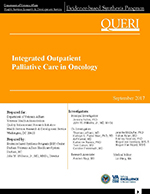
Principal Investigators: Jessica Fulton, PhD; John W. Williams, Jr., MD, MHSc
Co-Investigators: Thomas LeBlanc, MD; Jennifer McDuffie, PhD; Kathryn N. Porter Starr, PhD, RD; Soheir Adam, MD; Arif Kamal, MD; Andrzej Kosinski, PhD; Katherine Ramos, PhD; Megan von Isenburg, MSLS; Toni Cutson, MD; Megan Van Noord, MSIS; Caroline Freiermuth, MD
Download PDF: Complete Report, Executive Summary, Report, Appendices
More than 500,000 Americans, including 40,000 Veterans, are diagnosed with advanced cancer annually in the United States. Palliative care improves quality of life by managing patients' physical symptoms and psychosocial and spiritual distress, often provided concurrently with oncology care. Palliative care occurs across a continuum, beginning at the time of diagnosis of a serious illness and continuing until end of life. Integration of palliative care services with oncology care is now considered standard of care for patients with advanced cancer.
Palliative care has undergone increased acceptance and expansion, but understanding of its integration with oncology services is understudied and unclear. While primary care and oncology providers have always provided palliative care, palliative care has only recently become a recognized medicine specialty. Specialty palliative care is delivered in inpatient and outpatient settings and varies significantly in team composition, integration level, patients eligible for consultation, and utilization and cost-saving outcomes. However, which cancer patients may benefit most based on characteristics such as diagnosis, demographics, and stage of disease, as well as which delivery method is most effective, remain open questions.
With increase in availability of clinical palliative care services, health care organizations have tested and implemented degrees and types of integration with oncology care. Leaders have described various integration methods, including co-rounding models for hospitalized patients, embedded or colocated outpatient clinical services, and stand-alone clinics or services. Outpatient settings are where the majority of cancer care is delivered and has been considered the "next frontier" of community-based palliative care services.
1: In patients with symptomatic or advanced cancer, what are the benefits and harms of integrated outpatient palliative and oncology care compared with usual oncology care?
2: Which features of integrated palliative and oncology care are associated with greater benefit to patients with symptomatic or advanced cancer?
3: What are the most common and important barriers to implementing integrated palliative and oncology care in VA settings?
Fulton J, LeBlanc T, Cutson T, et al. Integrated outpatient palliative care for patients with advanced cancer: A systematic review and meta-analysis. Palliative Medicine. Published online November 29, 2018. https://doi.org/10.1177/0269216318812633
Evidence Report: Integrated Outpatient Palliative Care in Oncology (Management eBrief)